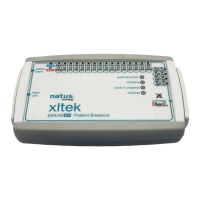Xltek
®
EMU40EX™ User and Service Manual
54
Red and infrared light-emitting diodes (LEDs) in oximetry sensors serve as the light sources, a
photodiode serves as the photodetector.
Traditional pulse oximetry assumes that all pulsations in the light absorbance signal are caused by
oscillations in the arterial blood volume. This assumes that the blood flow in the region of the sensor
passes entirely through the capillary bed rather than through any arterio-venous shunts. The traditional
pulse oximeter calculates the ratio of pulsatile absorbance (AC) to the mean absorbance (DC) at each of
two wavelengths, 660 nm and 905 nm:
S(660) = AC(660)/DC(660)
S(905) = AC(905)/DC(905)
The oximeter then calculates the ratio of these two arterial pulse-added absorbance signals:
R = S(660)/S(905)
This value of R is used to find the saturation SpO
2
in a ook-up table built into the oximeter’s software. The
values in the look-up table are based upon human blood studies against a laboratory co-oximeter on
healthy adult volunteers in induced hypoxia studies.
The Masimo SET
®
pulse oximeter assumes that arterio-venous shunting is highly variable and that
fluctuating absorbance by venous blood is the major component of noise during the pulse. The Masimo
SET
®
pulse oximeter decomposes S(660) and S(905) into an arterial signal plus a noise component and
calculates the ratio of the arterial signals without the noise:
S(660) = S1 + N1
S(905) = S2 + N2
R = S1/S2
Again, R is the ratio of two arterial pulse-added absorbance signals and its value is used to find the
saturation SpO
2
in an empirically derived equation into the pulse oximeter’s software. The values in the
empirically derived equation are based upon human blood studies against a laboratory co-oximeter on
healthy adult volunteers in induced hypoxia studies.
The above equations are combined and a noise reference (N’) is determined:
N’ = S(660) - S(905) x R
If there is no noise N’ = 0: then S(660) = S(905) x R which is the same relationship for the traditional
pulse oximeter.
The equation for the noise reference is based on the value of R, the value being sought to determine the
SpO
2
. The pulse oximeter’s software sweeps through possible values of R that correspond to SpO
2
values between 1% and 100% and generates an N’ value for each of these R-values. The S(660) and
S(905) signals are processed with each possible N’ noise reference through an adaptive correlation
canceler (ACC) which yields an output power for each possible value of R (i.e., each possible SpO
2
from
1% to 100%). The result is a Discrete Saturation Transform (DST™) plot of relative output power versus
possible SpO
2
value as shown in the following figure where R corresponds to SpO
2
= 97%:

